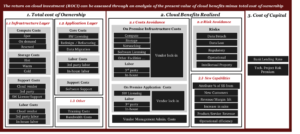Understanding the return on your cloud investments
By Ritesh Ramesh, Data and Analytics Leader, Consumer Markets, PwC U.S
Craig Scalise, Ph.D., Senior Research Fellow, PwC U.S.
According to a recent Forbes article 1, the seven biggest enterprise cloud vendors posted cloud revenue of $76.3 billion USD – a solid indicator of exponential growth and ongoing demand for cloud services among enterprises.
As advanced analytics, IoT AND artificial intelligence capabilities proliferate in the coming years, companies will accelerate the transformation of their IT infrastructure and underlying cost structures to be more agile and variable.
Corporate managers face the daunting task of unpacking the overall cost components and making wise decisions to drive and measure their cloud investments. In this article, we discuss a framework for organizing the economic components for the cloud and leading practices that managers need to consider while calculating their return on cloud investments (ROCI). The return on cloud investment (ROCI) can be assessed through a standard analysis of the present value of cloud benefits less total cost of ownership
Overview of economic components for the cloud
- Total Cost of Ownership – Compute, storage, labor and support costs involved both at the infrastructure and application layers to build and operate assets on the cloud. One-time migration, training and building bandwidth and networking to the cloud are all included
- Cloud Benefits Realized – This includes the cost savings that are derived from migrating to the cloud both at the infrastructure and application layers
– economic value of risks avoided by securing data, complying with regulatory requirements and customer SLA’s while moving to the cloud
– economic value that you can attribute to the business benefits achieved through enabling new capabilities such as a new product or service, increase in revenue, sales or margins, customer acquisition or retention and operational efficiencies - Cost of capital – Cost of capital used to fund the cloud program
Figure 1: An overview of economic components for the Cloud (Source: PwC)
Leading practices to calculate return on cloud investment (ROCI)
- Understand the pricing models of the cloud vendors being assessed: Each cloud vendor differs in their unit of cost, selection choices and price per unit measure. Leverage the cloud economics framework outlined here as a starting point to understand the pricing structure and variables for the cloud vendors being assessed.
- Conduct a Business Risk Assessment: Conduct a business risk assessment for allocating economic value to benefits derived from risk avoidance and measuring the impact of choosing a specific cloud vendor with your external stakeholders such as suppliers, customers and strategic partners. We have recently observed that many companies are forced to pursue a multi-cloud strategy due to concerns from their external partners not to host their data and related analytics with a specific cloud provider.
- Assemble a cross functional cloud strategy team: Assemble a cross functional team of enterprise architects, financial modelers , cloud experts and your external partners to assess and make critical design decisions on future state functional and non-functional requirements for the cloud such as compute, storage, environments, code refactoring, availability, disaster recovery etc. Technical and design decisions have a major impact on your final cost structure on the cloud.
- Don’t ignore switching costs and net new benefits value: Consider one-time switching costs and net new benefits realized over time in addition to the total cost of ownership while calculating your ROCI. For example, the decision to migrate from the current on premise vendor to a new cloud vendor will certainly involve high switching costs which will delay benefits realization and results in low ROCI during the initial years whereas low switching costs and rapid benefit realization within the first year will result in a high ROCI. IT leaders must work with their business peers in forecasting and measuring benefits attributed to new capabilities enabled by the cloud infrastructure quantitatively to get a holistic picture of their return on cloud investments.
- Choose PaaS vs. IaaS: Assess and select cloud native services as much as possible over procuring software and installing it on the cloud since the former not only eliminates overhead in licensing, maintenance and support costs but also accelerates benefits realization over a short time period which results in a better ROCI.
- Pick the right mix of compute instances: Analyze your current computational workloads and future requirements to choose the right mix of instance types (e.g. reserved, on-demand or spot) on the cloud. Conduct performance testing pilots of your workloads before finalizing the optimal ratio of instance types, nodes and cores required. The right optimization of reserved vs. spot vs. on-demand compute instances with the right amount of cores can lower monthly cloud consumption costs by 5X which can result in millions of dollars in annual savings.
- Define a tiered storage strategy: Define customer SLA’s and requirements to finalize a tiered storage strategy (hot vs. warm vs. cold) based on availability, accessibility and frequency of use. Choose the appropriate cloud service based on the storage tier to optimize costs. Many cloud vendors charge customers only for data retrieval from their cloud.
- Calculate One-time Migration Costs: Perform technical analysis coupled with logical assumptions to compute redesign, code refactoring and data migration costs. These costs ideally are one-time but can end up being cost prohibitive based on the complexity and benefits realization path.
References
